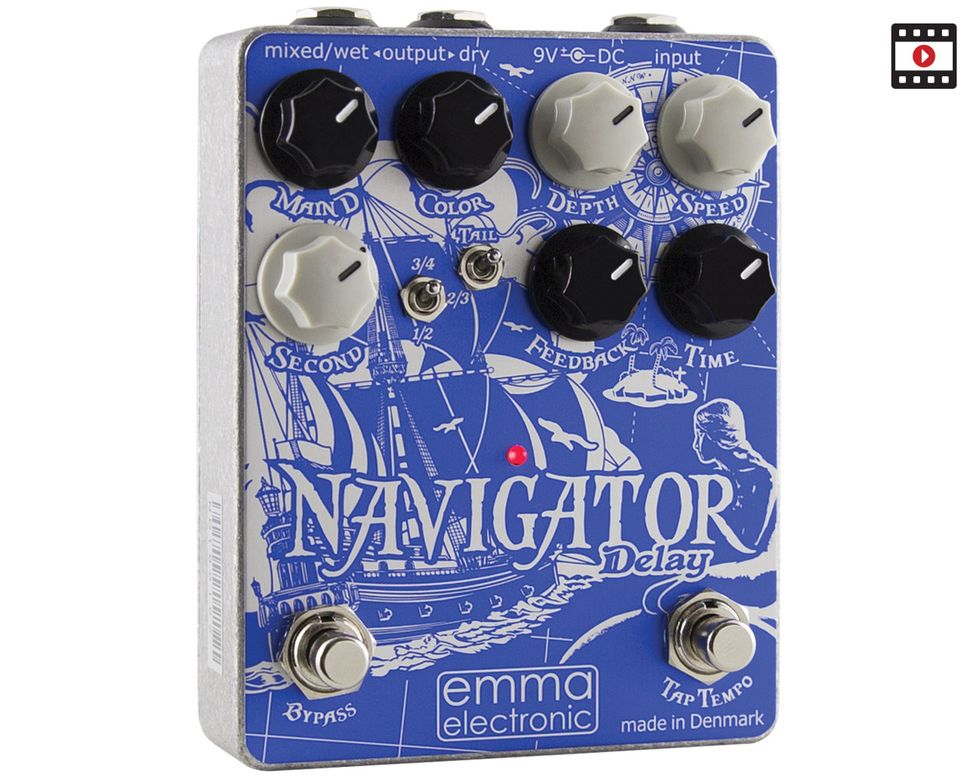RatingsPros:Compact size. Rich compound delay textures in a single pedal. Cool modulation textures without delay. Cons: Lack of expression pedal functionality for delay levels. Traces of artifacts at high mix levels could scare the digitally averse. Slightly expensive. Street: $259 EMMA Electronic Navigator emmaelectronic.com | Tones: Ease of Use: Build/Design: Value: |
These days, delay effects range from mundane to insane. And how far you want to go in either direction is really down to your patience, budget, and thirst for unconventional or extra-expansive sounds. On the mundane side of town, simple analog and digital echo units are, of course, less expensive and more compact than ever. But powerful DSP-driven multi-function delays take echo to freakish extremes—adding modulation and additional ambience that positively mangle time and space. EMMA Electronic’s Navigator digital delay lives somewhere between those two extremes, offering simple, basic echo functionality and easy-to-access texturizing functions than can add many rainbows worth of tone color with a minimum of fuss.
The key to the Denmark-built Navigator’s most unique textures is a second delay that can be subdivided, blended, and mixed in relation to the primary delay voice. The basic concept will be familiar to anyone who has ever used a multi-head delay like a Roland Space Echo, Watkins Copicat, Binson Echorec, or a digital emulation of those devices. But the ability to mix the two delayed signals individually gives the Navigator a big bag of sounds and an operational feel that’s unique, intuitive, inspiring, and fun.
Navigation, No Problem
The Navigator Delay walks a welcome middle ground between the simplest delays and DSP monsters that bristle with multi-function knobs and menus. In some respects the control set is a bit odd. The most basic and essential controls—for main delay level, color (delay tone), feedback, and delay time—are situated in separate rows but visually grouped by using black knobs. Placing these knobs in the same row seems like a more logical organizational approach, but the group-by-color scheme is easy to navigate with a little practice.
Any difficulty finding exactly the setting you need is usually chalked up to the range and sensitivity of the various knobs. In general, that range is a welcome part of the Navigator’s performance envelope, but if you plan to make the Navigator a mainstay for live performance, you may want to mark, document, or memorize a few preferred settings—particularly because these controls are highly interactive, and small adjustments to a single knob can dramatically transform the whole.
Two of the white knobs are dedicated to the modulation section of the circuit, which adds many dimensions of complexity to the already rich textures from the twin delays. The third white knob controls the blend level for the second delay. And the small toggle just to its right enables selection of three subdivisions for the second delay. Because feedback, time, and modulation settings are global for each delay, the subdivision switch and wet/dry mix are the only means of differentiating the texture of the second delay. As it turns out, this is more than ample equipment to create echoes from simply rich to wild. The pedal’s construction, by the way, is clean and reveals careful execution inside and out. The two-tiered circuit board even leaves enough room for a 9V battery.
Spiraling Spaceward
The Navigator’s basic delay tone is very nice and classically digital: clean, pristine, sure to cut in a mix, but easily and convincingly made analog-ish with darker tones from the color control and a touch of modulation or quasi-tape wobble.
Though you can coax genuine weirdness and many musically unconventional delay settings from the Navigator, some of the most engaging and immersive echo sounds come from ducking the second delay just behind the first and letting the subdivided delays peek out in more subtle and ephemeral ways. Take the long delay setting suggested in the Navigator’s user manual and demonstrated in audio Clip 1. It calls for a 50/50 wet/dry mix on the primary delay, a chorus-like modulation setting, and a half-time subdivision for the second delay, which sits just a few notches lower than delay 1 on the wet/dry setting.
When you remove the second delay entirely, the primary delay sounds nice enough for slow soloing, but it’s a bit uptight and regular. Mixing in the second delay, however, transforms the output—adding light, space, and a subtly bubbling and kinetic undertow that lends mystery and size to lead lines and nudges chords and arpeggios in ethereal, Slowdive-style directions that make a single chord sound like a whole cosmos. At half-note subdivisions, settings like these still sound uncluttered for all their vastness. But even three-quarter and two-third interval subdivisions can be made to sound less cluttered at the right wet/dry mix, and you can also use the color/tone control to de-emphasize the percolating, subdivided delays until the blend is spot on. Sounds this lush do, at times, leave you wanting for true stereo functionality rather than the wet and dry outputs the Navigator provides for two-amplifier rigs. On the other hand, they are positively expansive in mono.
The Verdict
For any player that uses two delays in an effects line to create complex echo textures, the Navigator is a cool-sounding, flexible, streamlined, and easy-to-use alternative that eliminates the guesswork and muddy sounds that can make two-delay rigs impractical.
True stereo outputs and expression pedal functionality for the level of the second delay would be a blast. And the economical circuit board layout suggests such additions might have been possible without a larger enclosure. But such functions would be cherries on top of an already pretty rich dessert. And whether you seek the subtlest additional coloration for your echoes, or something much wilder and abstract, the Navigator can show you the way.
Watch the First Look:








![Rig Rundown: Russian Circles’ Mike Sullivan [2025]](https://www.premierguitar.com/media-library/youtube.jpg?id=62303631&width=1245&height=700&quality=70&coordinates=0%2C0%2C0%2C0)


























